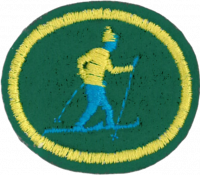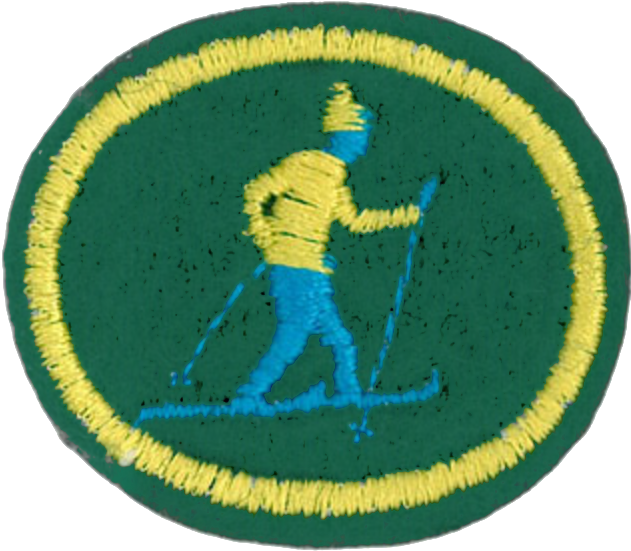Difference between revisions of "AY Honors/Skiing - Cross Country/Answer Key/es"
From Pathfinder Wiki
< AY Honors | Skiing - Cross CountryAY Honors/Skiing - Cross Country/Answer Key/es
(Created page with "{{clear}}") |
(Updating to match new version of source page) |
||
| (13 intermediate revisions by 2 users not shown) | |||
| Line 1: | Line 1: | ||
| − | + | {{HonorSubpage}} | |
| − | + | <!--{{Honor_Master|honor=Skiing - Cross Country|master=Recreation}}--> | |
| − | {{ | ||
| − | |||
| − | |||
| − | |||
| − | |||
| − | |||
| − | |||
| − | |||
| − | }} | ||
| − | |||
| − | {{Honor_Master | ||
| − | |||
| − | |||
| − | |||
<section begin="Body" /> | <section begin="Body" /> | ||
{{ansreq|page={{#titleparts:{{PAGENAME}}|2|1}}|num=1}} | {{ansreq|page={{#titleparts:{{PAGENAME}}|2|1}}|num=1}} | ||
<noinclude></noinclude> | <noinclude></noinclude> | ||
| − | <!-- 1. | + | <!-- 1. Hacer una lista y describir las principales características, calidades y el tamaño de los siguientes equipos de esquí de fondo: --> |
<noinclude></noinclude> | <noinclude></noinclude> | ||
{{ansreq|page={{#titleparts:{{PAGENAME}}|2|1}}|num=1a}} | {{ansreq|page={{#titleparts:{{PAGENAME}}|2|1}}|num=1a}} | ||
| Line 42: | Line 28: | ||
{{clear}} | {{clear}} | ||
| − | + | {{clear}} | |
| − | + | {{clear}} | |
| − | |||
| − | |||
| − | + | {{clear}} | |
| − | |||
<noinclude></noinclude> | <noinclude></noinclude> | ||
| Line 66: | Line 49: | ||
{{ansreq|page={{#titleparts:{{PAGENAME}}|2|1}}|num=2}} | {{ansreq|page={{#titleparts:{{PAGENAME}}|2|1}}|num=2}} | ||
<noinclude></noinclude> | <noinclude></noinclude> | ||
| − | <!-- 2. | + | <!-- 2. Describir y demostrar cómo los artículos anteriores se prepararán para el uso y el cuidado que se la dan tanto en el campo como durante fuera de temporada. --> |
| − | |||
| − | |||
| − | |||
| − | |||
| − | |||
| − | |||
| − | |||
| − | |||
| − | |||
| − | |||
| − | |||
<noinclude></noinclude> | <noinclude></noinclude> | ||
| − | |||
| − | |||
<noinclude></noinclude> | <noinclude></noinclude> | ||
<noinclude></noinclude> | <noinclude></noinclude> | ||
| − | |||
{{CloseReq}} <!-- 2 --> | {{CloseReq}} <!-- 2 --> | ||
{{ansreq|page={{#titleparts:{{PAGENAME}}|2|1}}|num=3}} | {{ansreq|page={{#titleparts:{{PAGENAME}}|2|1}}|num=3}} | ||
<noinclude></noinclude> | <noinclude></noinclude> | ||
| − | <!-- 3. | + | <!-- 3. ¿Qué consideración debe hacerse al seleccionar la ropa que debe usar mientras se hace esquí de fondo? ¿Qué características tendría que buscar a la hora de seleccionar un paquete para un viaje de esquí? --> |
<noinclude></noinclude> | <noinclude></noinclude> | ||
{{CloseReq}} <!-- 3 --> | {{CloseReq}} <!-- 3 --> | ||
{{ansreq|page={{#titleparts:{{PAGENAME}}|2|1}}|num=4}} | {{ansreq|page={{#titleparts:{{PAGENAME}}|2|1}}|num=4}} | ||
<noinclude></noinclude> | <noinclude></noinclude> | ||
| − | <!-- 4. | + | <!-- 4. Demostrar correctamente las siguientes técnicas de esquiar: --> |
<noinclude></noinclude> | <noinclude></noinclude> | ||
{{ansreq|page={{#titleparts:{{PAGENAME}}|2|1}}|num=4a}} | {{ansreq|page={{#titleparts:{{PAGENAME}}|2|1}}|num=4a}} | ||
| Line 138: | Line 107: | ||
{{ansreq|page={{#titleparts:{{PAGENAME}}|2|1}}|num=5}} | {{ansreq|page={{#titleparts:{{PAGENAME}}|2|1}}|num=5}} | ||
<noinclude></noinclude> | <noinclude></noinclude> | ||
| − | <!-- 5. | + | <!-- 5. Explicar los propósitos de encerar. Explicar brevemente la necesidad de diferentes ceras para diferentes clases de nieves y temperaturas. --> |
<noinclude></noinclude> | <noinclude></noinclude> | ||
{{CloseReq}} <!-- 5 --> | {{CloseReq}} <!-- 5 --> | ||
{{ansreq|page={{#titleparts:{{PAGENAME}}|2|1}}|num=6}} | {{ansreq|page={{#titleparts:{{PAGENAME}}|2|1}}|num=6}} | ||
<noinclude></noinclude> | <noinclude></noinclude> | ||
| − | <!-- 6. | + | <!-- 6. Explicar las precauciones básicas de seguridad a seguir en el esquí de fondo. --> |
<noinclude></noinclude> | <noinclude></noinclude> | ||
{{CloseReq}} <!-- 6 --> | {{CloseReq}} <!-- 6 --> | ||
{{ansreq|page={{#titleparts:{{PAGENAME}}|2|1}}|num=7}} | {{ansreq|page={{#titleparts:{{PAGENAME}}|2|1}}|num=7}} | ||
<noinclude></noinclude> | <noinclude></noinclude> | ||
| − | <!-- 7. | + | <!-- 7. Conocer y explicar las normas de conducta oficiales nacionales de esquí de fondo. --> |
{{clear}} | {{clear}} | ||
| Line 158: | Line 127: | ||
{{ansreq|page={{#titleparts:{{PAGENAME}}|2|1}}|num=8}} | {{ansreq|page={{#titleparts:{{PAGENAME}}|2|1}}|num=8}} | ||
<noinclude></noinclude> | <noinclude></noinclude> | ||
| − | <!-- 8. | + | <!-- 8. Demostrar capacidad de esquiar de la siguiente manera: --> |
<noinclude></noinclude> | <noinclude></noinclude> | ||
{{ansreq|page={{#titleparts:{{PAGENAME}}|2|1}}|num=8a}} | {{ansreq|page={{#titleparts:{{PAGENAME}}|2|1}}|num=8a}} | ||
| Line 178: | Line 147: | ||
==Referencias== | ==Referencias== | ||
<noinclude></noinclude> | <noinclude></noinclude> | ||
| − | + | {{CloseHonorPage}} | |
| − | |||
Latest revision as of 23:05, 18 July 2022
Esquí de fondo
Nivel de destreza
2
Año
1986
Version
21.12.2025
Autoridad de aprobación
Asociación General
1
Hacer una lista y describir las principales características, calidades y el tamaño de los siguientes equipos de esquí de fondo:
1a
Esquís (tanto los que se enceran y los no se enceran)
1b
Fijación de la bota
1c
Botas
1d
Palos
2
Describir y demostrar cómo los artículos anteriores se prepararán para el uso y el cuidado que se la dan tanto en el campo como durante fuera de temporada.
3
¿Qué consideración debe hacerse al seleccionar la ropa que debe usar mientras se hace esquí de fondo? ¿Qué características tendría que buscar a la hora de seleccionar un paquete para un viaje de esquí?
4
Demostrar correctamente las siguientes técnicas de esquiar:
4a
Zancadas plana con una buena patada, adquisición y la forma
4b
Movimiento con un solo palo, el cambio y con los dos palos
4c
Por el lado subiendo y bajando pendientes
4d
Subiendo la pendiente estilo Herriingbone
4e
Atravesar al lado subiendo la pendiente con zancadas de vuelta
4f
Escalada de pendiente hacia arriba
4g
Descenso recto corriendo bajo control, en pendiente de 20 grados (schuss)
4h
Moviéndose bajando la pendiente
4i
Arando nieve para frenar la velocidad y detenerse
4j
Sentado de espalda deteniéndose
5
Explicar los propósitos de encerar. Explicar brevemente la necesidad de diferentes ceras para diferentes clases de nieves y temperaturas.
6
Explicar las precauciones básicas de seguridad a seguir en el esquí de fondo.
7
Conocer y explicar las normas de conducta oficiales nacionales de esquí de fondo.
8
Demostrar capacidad de esquiar de la siguiente manera:
8a
Tomar tres senderos de 3 millas (4.5 km) separados con otro individuo. Si es posible, tener diferentes condiciones de nieve.
8b
Tomar un viaje de 10 millas (16 km) en diversos terrenos.
8c
Durante todos los recorridos es necesario llevar el equipo (de seguridad) y usar ropa adecuada para las condiciones demostrando la capacidad de mantener su propia temperatura corporal, sequedad y condición.


